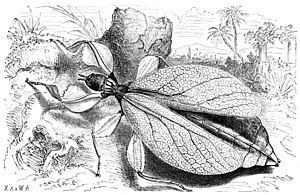Phyllium siccifolium
| Phyllium siccifolium | ||||||||||||
|---|---|---|---|---|---|---|---|---|---|---|---|---|

Phyllium siccifolium , representation of a female in Brehm's Thierleben |
||||||||||||
| Systematics | ||||||||||||
|
||||||||||||
| Scientific name | ||||||||||||
| Phyllium siccifolium | ||||||||||||
| ( Linnaeus , 1758) |
Phyllium siccifolium , more precisely Phyllium (Phyllium) siccifolium (from gr. Φύλλον = leaf and Latin siccus = dry, folium = leaf - 'dry leaf') is the longest known species of walking leaves (Phylliidae). It was already described by Linnaeus in 1758under the name Gryllus siccifolius lauri and, together with Phasma gigas and Pseudophasma phthisicus, is one of the three first described species of ghost horror . In the English-speaking world, the species is named "Linnaeus' Leaf Insect" in honor of its first descriptor.
Systematics
Phyllium siccifolium is assigned to the subgenus Phyllium , which differs from the subgenus Pulchriphyllium by the lack of praise on the outside of the fore tibia . Thus the full species name is Phyllium (Phyllium) siccifolium . The holotype is a female animal that is located in the Zoological Institute of Uppsala University .
Hennemann et al. also propose to divide the genus Phyllium into species groups below the subgenera. Phyllium siccifolium is suggested as eponymous for the siccifolium species group .
The species was described several times in the 18th and 19th centuries under the different names listed here. These are now considered synonyms for Phyllium siccifolium :
- Phyllium brevicorne Latreille , 1807
- Phasma chlorophyllia Stoll , 1813
- Phyllium chlorophyllia ( Stoll , 1813)
- Phasma citrifolium Lichtenstein , 1796
- Phyllium donovani Gray, GR , 1835
- Mantis foliatus Perry , 1811
- Gryllus folium lauri Linnaeus , 1754
- Phyllium gorgon Gray, GR , 1835
- Phyllium stollii Lepeletier & Serville , 1825
According to Hennemann et al. Phyllium tobeloense
Bigger , 2007 is said to be synonymous with Phyllium siccfolium . Detlef Larger, who used this type and a. on the basis of an egg taken from the ovipositor , contradicted this in a more recent work and argued that Hennemann et al. In the same work, the same method was used to delimit and re-describe Phyllium mindorense Hennemann , Conle , Gottardo & Bresseel , 2009. The species is now considered valid again.
Furthermore, Larger shows on the basis of comparative studies of the internal sclerite of the females as well as the eggs and hatchlings that Phyllium bilobatum , Phyllium hausleithneri and the newly described Phyllium philippinicum have very similar and strongly varying characteristics, so that they are also synonyms or subspecies of Phyllium siccifolium could act.
Occurrence
Although it is not yet finally clear how large the range of the species actually is, its occurrence in the Moluccas is considered certain. This can be explained by the fact that the holotype collected by Carl von Linné very likely comes from the island of Ambon or a neighboring Moluccan island. In addition to Ambon, Phyllium siccifolium is also found on the islands of Halmahera , Seram (formerly Ceram), Buru , Banggai and the Sula Islands . In contrast, it is disputed whether the animals from China , Malaysia , India and the Philippines are actually Phyllium siccifolium or must be counted among other closely related species of the siccifolium species group .
Keeping in the terrarium
After many years of assuming that the strain from West Malaysia listed by the Phasmid Study Group under PSG number 76 is Phyllium siccifolium , Hennemann et al. assume that these animals belong to Phyllium hausleithneri , while both the Phasmid Study Group and Detlef Larger continue to refer to these animals as Phyllium siccifolium . The Phyllium spec. , Which is listed under PSG number 278 . (Philippines) is also still suspected of being Phyllium siccifolium . Since this was described as Phyllium philippinicum in 2009 , Phyllium siccifolium is, according to Hennemann et al. not yet in breeding.
Web links
- www.phyllium.de Phyllium siccifolium on the Phyllium website by Detlef Großer
- www.phasmatodea.com - Phasmid page by Frank H. Hennemann & Oskar V. Conle with pictures of Phyllium siccifolium
Individual evidence
- ^ Phasmatodea page by Oskar V. Conle and Frank H. Hennemann
- ^ A b Paul D. Brock : Phasmida Species File Online . Version 2.1 / 4.0 (accessed April 11, 2011)
- ↑ a b c d Frank H. Hennemann, Oskar V. Conle, Marco Gottardo & Joachim Bresseel : Zootaxa 2322: On certain species of the genus Phyllium Illiger, 1798, with proposals for an intra-generic systematization and the descriptions of five new species from the Philippines and Palawan (Phasmatodea: Phylliidae: Phylliinae: Phylliini) , Magnolia Press, Auckland, New Zealand 2009, ISSN 1175-5326
- ↑ Detlef Larger : Wandering Leaves , Edition Chimaira, 2001, Frankfurt am Main. ISBN 3-930612-46-1
- ↑ a b c Detlef Larger: New Insights and Critical Remarks on certain species of Walking Leaves (Insecta: Phasmatodea: Phylliidae) , Arthropoda Generalis 3, Sungaya Verlag 2011, ISSN 2191-4427
- ↑ PSG Culture List on the Phasmid Study Group website .